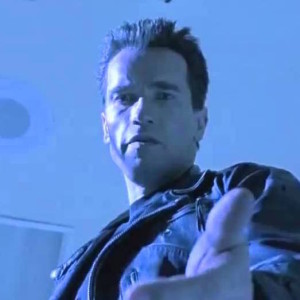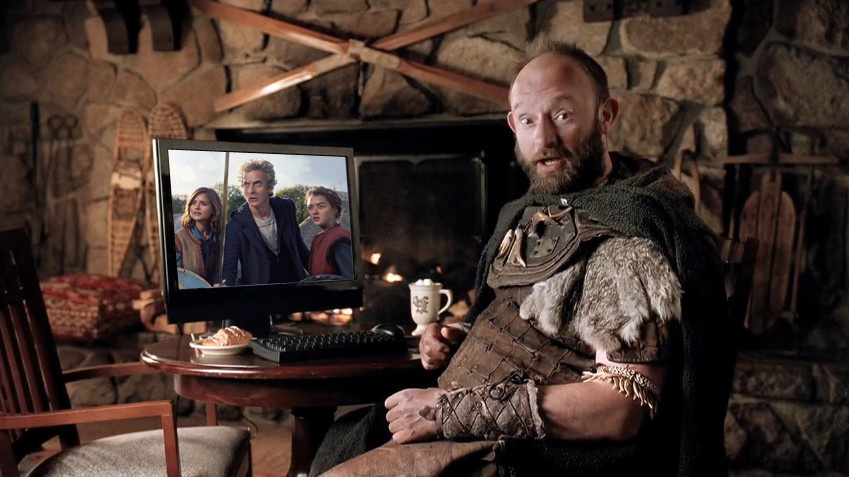“The Girl Who Died” is the best written, least formulaic story of the Capaldi era. Historical and scientific implausibilities are outweighed by overall emotion and character growth. The Doctor fights Vikings, alien invaders, and his own conscience.
Like most of Series 9, “The Girl Who Died” (written by Jamie Mathieson and Steven Moffat) has a terrific start. Concluding an undocumented adventure, Clara’s in danger and the Doctor’s trying to find her. The rescue does more than entertain with action and banter, though Capaldi and Coleman are clearly hitting their stride. The scene also provides a reason for their unplanned arrival in Viking-era England (the exact setting is unspecified; pick a year between 790 and 1066.) This random TARDIS materialization calls back to less formulaic stories (An Unearthly Child, The War Games, The Caves of Androzani, “Dalek“)where the Doctor’s only objective is getting back to the TARDIS in one piece.
Ripples vs. Title Waves
Clara’s an intriguing character this year, a welcome improvement. As show runner and co-writer, Moffat seems to be making up for her inconsistent characterization in Season 8. Having seen the Doctor transform from young flirty boyfriend to cranky old man, her growing interest in the rules of time travel are completely legitimate. Clara’s reasons for joining the Doctor, however, seem more unbalanced in every episode so far. Their conversations show that there is no psychologically sound reason to join him. His disregard for mundane life is romantic at best, reckless at worst. Missy’s reasons for choosing her are obvious: only a disconnected personality would sign up. Their relationship isn’t friendship; it’s mutual addiction.
Two Days on a Longboat
The Doctor/Clara hostage bickering is reminiscent of he and River Song in “Rain Gods,” another indication of just how emotionally dependent they are. Moffat’s trying to tell us something about this Doctor, perhaps with “premonition is remembering in the wrong direction.” In spite of the actual Viking history of looting, murder and human trafficking, our heroes believe they can somehow joke their way out of this. As far as historical accuracy, this story owes more to The Gunfighters than The Aztecs.

Then again, Doctor Who has always shown human atrocity through a sci-fi fantasy, safe for children filter. Settings of most Doctor Who period stories (“Daleks In Manhattan,” “Family of Blood,” “The Shakespeare Code“) are rooted in fictional history as opposed to actual history. Even this episode feels like a Capital One commercial. This child-driven sanitization of Doctor Who is out of step with current viewing habits. The BBC’s Saturday night time slot (8:20 in England, 9:00 in America) means the youngest viewers are teenagers exposed to actual news and history. Placing more emphasis on history and physics won’t turn Doctor Who into Torchwood or Judge Dredd.
This scene flows really well. Ashildr really did “remember in the wrong direction.” The Doctor’s fake Odin trick only backfired because the Mire beat him to it (assuming this isn’t the Mire’s first visit.) “Odin” in the clouds was too silly, but the Vikings never saw Monty Python and the Holy Grail. From the Mire’s perspective, it’s actually a great plan.
While the warriors get abducted, Clara goes against the Doctor’s orders to “not get chosen.” In this instant, she’s the Doctor. She bolts for Ashildr, under the premise of wanting her shackles off. In truth, she’s hoping the aliens detect the sonic glasses as advanced technology. Clara’s instructions sound like “magic in her real world.” Her trick worked, leaving the Doctor, whose TARDIS is two days on a long boat ride away.
Welcome to Valhalla
Once on the ship, Clara makes a pretty good Doctor. She tried everything possible to save herself and the Vikings, and appeared ready to die for a second. Her life on Earth means nothing. Then came the onslaught of writer’s construct: Clara abandons the men, taking Ashildr as her damsel in distress. Somehow, they’re not killed by the wall blasters. Why didn’t the warriors crawl under the blasts? They might not have been book smart, but Vikings were far from helpless.
Clara’s survival and analytical skills work well against the Mire leader. She’s certainly a better liar than Rose Tyler, who was placed in a similar situation in “The Christmas Invasion.” Clara’s fashion model spin drove this point home. She clearly learned something from her time with the Doctor. Going against the show’s formula, she negotiates a peaceful settlement…which Ashildr completely ruins by declaring war. Was she trying to impress Clara, or is it a pure emotional reaction to “Odin” turning her warriors into a testosterone fix? We’re not with her long enough to know. While we’re here, Odin’s testosterone addiction explains his Jekyll/Hyde parenting to Thor and Loki.
Meanwhile, the Doctor’s rant is convincing. He’s got to do something while waiting and hoping for Clara’s return.
I’m Not a Hugger
Maybe his 2,000 year Diary reminded him of losses and bloodbaths. Something influenced his attempt to sell avoidance to Vikings. All his logic, charm and persuasion fall on stubborn ears. “Do babies die with honor?” is a great line, but too conveniently timed. Like a lot of action movies, political campaigns, and tire commercials, this scene uses cute kids to say what hack writers are too lazy to express by other means. How else did she get to be such an expressive poet laureate in 2 or 3 months? Oh yeah, that “fire in the water” vision means she’s also psychic. Like Neo, she’s “looking at the world without time.”
Ashildr’s plea for the Doctor to stay is unconvincing. Weren’t they ready to kill him half an hour ago? Ashildr’s having a rough time processing the war she caused. To that end, she hopes the Doctor can somehow make the consequences of her actions go away. He should have left.
It Will Be Spectacular
Clara’s got way too much faith in the Doctor. It’s certainly stronger than Amy Pond’s in “The God Complex,” where the villian murdered his victims with their own worship. His plea for Clara to find another hobby doesn’t work because (a) she’s too addicted to listen and (b) he’s unqualified to tell anyone how to handle their emotions. Watching the Doctor process his “duty of care” for Clara exposes his addiction for companions. It’s gone far past the tenth Doctor’s loneliness. He knows it’s wrong, but can’t stop himself from recklessly bringing humans into his dangerous lifestyle. Twelve isn’t the whimsical madman in a box.
“A good death is all one can hope for” is his last ditch effort to save her. Clara’s “start winning” speech is just as nonsensical as her “anyone can be a hero” speech in “Day of the Doctor,” and only works because of help from the writers.
Is Clara bisexual?
Later, the Doctor and Ashildr have a private chat. She still feels bad about everyone’s impending death, but now shows no remorse for causing it. Her “I will pity you” speech stinks of writer’s construct. In 3 viewings, I still don’t see the value in her being a sexual hybrid. In one speech, the writers awkwardly download the inner workings of a character we’ve been with since the episode’s beginning. This scene felt like an afterthought to move the plot along.
Fire in the Water
That precocious baby got the Doctor to invent electromagnetism at least 800 years early. This, combined with the seventh Doctor’s guile, is how he won. But how did South American electric eels get to England? The solution is “the good old Doctor flim-flam” disguised as science. We aren’t shown how many electric eels there are, but they couldn’t possibly generate enough power to wreck the Mire’s battle armor. Large eels can produce 600 volts, but they need to be in perpetual fear to do so. They’d need to be in aluminum tanks to conduct their power into wires. And where did the wires come from? There couldn’t be enough silver in Clara’s spacesuit (Norrin Radd didn’t have that much silver!) Perhaps they melted copper coins, which England had since the third century.
Good thing Mire’s battlefield helmets are made of ferromagnetic metal. If their defense contractor went with copper or zinc, the show would be rebranded as Missy’s Revenge.
Wanting this level of science accuracy might seem a bit much, but we were challenged to “Google it” just last week.
Convincing Hologram
Ashildr’s fear makes sense, but I wish she didn’t show it. Suspending the scientific improbability of the Doctor’s plan, it was spectacular. Armed only with his diary as reference, he used Ashildr to hack into the Mire’s network. Tony Stark better watch his back. “Teaching a man to fish,” he shares his psychological war techniques with the Vikings. It’s almost like he’s teaching young Doctor Who viewers how to deal with bullies.
Speaking of which, what is his exit plan for introducing electricity, iPhones, and Benny Hill to the Viking Age? He’s either going to wipe their memories, or hope enough of them die.
I’ll Lose Any War You Like

Why does Ashildr’s death trigger the Doctor’s melancholy? The Vikings didn’t blame him; they know she sacrificed her life for them. With so much prep work on short notice, the Doctor didn’t have time to consider how a Mire war helmet would affect a human. In context of the deaths he’s seen and caused, this reaction seems like a cheap way to get to the “why this face?” soliloquy. Russell T. Davies came up with this idea when Moffat cast Peter Capaldi as the twelfth Doctor. Davies hired Capaldi for “The Fires of Pompeii” and the Torchwood story “Children of Earth.” Speaking of Pompeii, the tenth Doctor’s “come with me” scene looks a lot like Terminator 2.
Is the twelfth Doctor’s Capaldi face a note-to-self saying it’s okay to play God, to decide who lives? Mr. Copper said that would make him a monster in “Voyage of the Damned,” and it didn’t work in “The Waters of Mars.” Why, even in a moment of rage, would the Doctor give anyone “functional immortality?” After realizing his error, he tells Clara “a good death is the best anyone can hope for.” He’s good at telling everyone else how to cope with death and loss, but “everybody else dying” doesn’t apply to him.
Our hero’s a bit hard on himself with the whole “running away from pain” thing. Personal loss is supposed to hurt; welcome to humanity. And as we found out in “The Name Of The Doctor,” a lot of planets got saved by his perceived emotional weakness.
What’s done is done. With a Mire’s battlefield medical kit that came from nowhere, the Doctor created a human/alien hybrid. Let’s hope it’s closer to the Doctor/Donna and not the half-human Time Lord in the 1996 Doctor Who movie.
Other than getting me dizzy, was there a point to Ashildr’s spinning green screen sunset scene?
